Could photothermal therapy become the ‘gold standard’ of cancer treatment?

The first clinical trial of photothermal therapy, a promising cancer treatment, has demonstrated successful results. While photothermal therapy has been extensively tested in preclinical models, this is the first trial assessing its suitability as a treatment for cancer patients.
What is photothermal therapy?
Photothermal therapy is a localized treatment paradigm suitable for the treatment of solid tumors. During the treatment, a photosensitizer is excited with electromagnetic radiation, commonly near-infrared. The photosensitizer absorbs the energy and converts it to heat, this induces local hyperthermia allowing highly precise ablation of the tumor.
Due to their easily modulated structure, nanoparticles are ideal candidates to act as photosensitizers. They have high optical absorbance which can be tuned to specific wavelengths of infrared radiation, increasing the specificity of the treatment.
Several different types of nanoparticles have been utilized in various studies of photothermal therapy. Numerous studies have reported on the suitability of graphene-based particles, due to their large surface area to volume ratio and strong biocompatibility.
As part of a study carried out by Zhuang Liu (Soochow University; Jiangsu, China) and colleagues in xenograft tumor mouse models, nanographene sheets were administered and then excited with near-infrared laser irradiation. The team observed high photoablation rates with minimal side effects.
In recent years, attention has turned to synthesizing graphene-based nanoparticles with integrated gold nanomaterial. In 2015, a collaborative project led by the Suzhou Institute of Nano-Tech and Nano-Bionics (China) utilized an aptamer—gold nanomaterial-hybridized graphene oxide as a photosensitizer to induce a therapeutic response in human breast cancer cell lines. This combination demonstrated strong conversion of energy to heat and increased antitumor activity.
Is all that glitters gold?
In a recent trial, conducted at the Icahn School of Medicine at Mount Sinai (NY, USA), a cohort of 16 men with low- to immediate-risk prostate cancer received AuroLase® therapy, a photothermal ablation treatment that utilizes specially engineered gold-silica nanoshells as photosensitizers.
The treatment was conducted over 2 days, with the patients receiving the nanoparticles intravenously on the first day. On the second day, guided by MRI and ultrasound, the team inserted optical fibers into the tumors, whilst the patients were under general anesthetic, to excite the nanoshells. Full coverage of the tumors was achieved with this method.
The patients were discharged the same day after undergoing the procedure. The patients also benefitted from minimal damage to healthy tissues surrounding the tumor, due to the increased specificity provided by photothermal therapy. Tissue damage in prostate cancer can have many adverse side effects, including erectile dysfunction and urinary incontinence.
AuroLase is a product of Nanospectra Biosciences (TX, USA), a startup founded by study co-authors Naomi Halas (Rice University, TX, USA) and Jennifer West (Duke University, NC, USA). Halas created the gold-silica nanoshells in 1997, she demonstrated that by varying the thickness of the gold shell, the nanoshells interactions with specific wavelengths of light could be tuned.
In 2003, Halas and West first demonstrated the effectiveness of the method in murine models and breast carcinoma cells. Mice were injected interstitially with the gold-silica nanoshells, the tumor sites were then exposed to near-infrared light and the internal temperatures monitored. The tumor tissue experienced irreversible thermal damage, suggesting that cancer cells treated using this method would not be able to recover.
Now the technique has shown to be an effective treatment for cancer patients. Of the 16 men, only one did not complete the two consecutive days of treatment after experiencing gastric pain. Of the 15 men who received AuroLase, 13 were shown to be cancer free in follow-up biopsies 1 year after receiving the treatment.
The huge milestone reached with this study will likely have a different, more personal impact for Halas, who sadly lost her father to prostate cancer throughout the course of this research.
“He said to me, ‘If you could prevent just one person from having to go through the hell that I went through, it would be worth it.”
- Nanoparticles used to deliver cancer inhibiting molecule
- High-dose, high reward? New potential treatment for prostate cancer
- Talking Techniques | Hans Keirstead on precision therapeutics for cancer and science in politics
Combining photothermal therapy with existing treatments
Whilst this study is the first published clinical trial using photothermal cancer therapy, it is certainly not a new concept. Numerous photothermal therapies have been developed and tested, but these existing strategies are often limited.
As such, current research has focused on developing new approaches to photothermal therapy or identifying effective therapies to use in conjunction.
Last year, researchers from the University of Delaware (DE, USA) demonstrated that a combination of photothermal and photodynamic therapies was effective at treating triple-negative breast cancer in cell culture models.
This preclinical trial, published in Nanomaterials, discovered that when the two therapies were used in combination, they required lower dosages and produced more cell death than either therapy alone.
Another study from researchers at the University of California, Los Angeles (CA, USA), and the University of North Carolina at Chapel Hill (NC, USA) suggested that combining photothermal therapy and CAR-T therapy was effective at treating melanoma in murine models.
The study, published earlier this year in Advanced Methods, tested this combination therapy in mice injected with melanoma tumors and found that tumor growth was suppressed for up to 20 days and 33% of these mice were still tumor free after 20 days.
What does the future hold for photothermal therapy?
Whilst the AuroLase clinical trial showed promising results, as none of the patients showed any adverse side effects 90 days post treatment, the small sample size meant that the treatments efficacy could not be formally assessed. However, the trial is ongoing and is currently treating the required 45 patients needed to reliably report on efficacy, the data should be published next year.
Regardless, this groundbreaking study will help to pave the way for future clinical trials investigating photothermal therapies and other novel cancer treatments, in part by making clinical trial approval easier to obtain.
“We were the first, really engineered nanoparticle to go into human beings,” West explained. “In the beginning, the FDA wasn’t sure how to handle these types of materials. We had something that looked like an injectable liquid in an IV bag. Was it a drug or a device? There was a point in time where the FDA was discussing creating a whole new division just for nano.”
However, the researchers believe that the true impact of the study may run deeper than just opening the door for future cancer therapies; “this work demonstrates the power of collaboration across engineering and medicine,” remarked West. “It shows how collaboration can enable the translation of exciting new technologies into clinical medicine to improve the lives of patients.”





